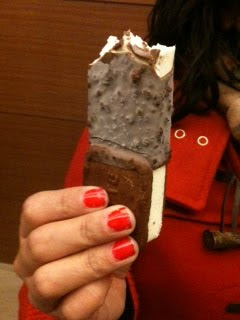Were we in any immediate danger? In retrospect, probably not. But you know what? When people start panicking around you and the words "radiation" and "nuclear meltdown" start getting thrown around, your natural reaction is to panic too. I'm not an expert on nuclear reactors and as adorable as the Chief Cabinet Secretary was in his workman's jumpsuit, he wasn't giving out a lot of information at the time.
So we're back in Tokyo now. I had heard that Tokyo was totally normal despite reports of a mass exodus. Tokyo is definitely not normal right now. Sure, shelves are fully stocked and there are people around, but this is definitely not the Tokyo I left on Tuesday. The city is dark. Literally. Many shops and restaurants are closed or open for only lunch or dinner. The famous Shibuya lights are off, trains are running at reduced schedules and most escalators in the subway are off too. This is all in an effort to avoid blackouts.
So, what'd I do in Nagoya? I tried my best not to watch a lot of news, especially western channels. I watched a lot of news stories twice - the original broadcast in Japanese on NHK which reported the facts and then the CNN version which was made to make me cry. To be quite honest, I was totally confused by all my friends' Facebook statuses telling me that they were in tears over what they were watching. I totally get it now.
I visited the Nagoya Aquarium on a quiet Wednesday afternoon. It was the perfect place for me to reflect and take a deep breath. I've been to quite a few aquariums in Japan and this one is pretty well put together.
We were hearing that food and supplies were running scarce in the Tokyo area, so ABC Cooking School friend and I picked up some stuff to donate to Second Harvest Japan. We looked pretty cool buying 12 packs of ladies sanitary napkins and baskets full of Soy Joys.
By the way, this is where I recommend donating to Second Harvest. They have trucks making daily runs to Miyagi Prefecture, where the tsunami hit. These trips don't pay for themselves!
Ate some delicious food such as this inside out オムライス (omelet rice).
My favorite Nagoyan treat? きしめん. Kishimen are flat udon noodles and they're a Nagoyan delicacy. They're cheap and fun to slurp.
Took a day trip to Ise which is famous for it's shrines, most notably Ise Jingu, the holiest shrine in Japan. Kyoto is also known for their shrines, but the ones in Ise are not like anything I've ever seen in Japan. They are simple, very traditional and even though the majority of the site is off limits to the public, it's still a great place to visit. This might be the one place in Japan where you can't find a vending machine. It was a nice peaceful day. We just walked around the forest that surrounds the shrines and took in the 500 year old trees and power spots.
What is a power spot you ask? Well, this is a relatively new craze in Japan. Crash course in Japanese spirituality: In Japan, there's Buddhism and there's Shinto. If you're Japanese, you are Shinto. Shinto isn't a religion, but more a spiritual guide. Many Japanese are both Buddhists and Shinto. Shintoists believe that their deities take the form of rocks and trees and some of these rocks, trees and shrines have been deemed "power spots" by travel agencies.
This explains why so many people were hugging trees and waving their hands over rocks throughout the forest.
On our way back to Tokyo, I ate some delicious red bean filled mochi while whizzing by the countryside. It's hard not to think about how acres of land that looked just like this just a week ago are completely gone.
And on that, I'm going to end with a few more donation options.













